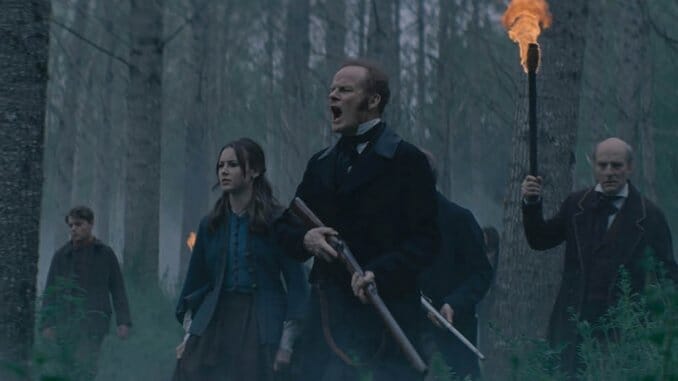A cursed burial ground. Children singing a creepy nursery rhyme. A shadowy outsider who holds the key to survival. If these all strike you as clichéd imperatives for your average werewolf movie, then rest assured: British writer/director Sean Ellis’s latest film Eight for Silver—a protracted folkish horror story that mistakes miserablism for period accuracy—is, indeed, a werewolf movie.
The film begins by dropping the viewer smack-dab in the trenches of World War I before suddenly jumping back 35 years prior to a seemingly undisturbed British town in the 19th century. The stark terror of war is meant to mirror the atrocities committed by British townsfolk on a Romani encampment on the outskirts of their village—a scene which prevails as the most viscerally disturbing in the film, ultimately overshadowing the ensuing creature kills. Though the entire Romani population has been murdered, their spiritual presence persists as the British occupants are suddenly hunted by a horrifying predator. Unsurprisingly, the beast is particularly drawn to the manor of Seamus Laurent (Alistar Petrie), the de facto orchestrator of the Romani massacre. When Seamus’ son Edward (Max Mackintosh) suddenly goes missing, he has no choice but to call in pathologist Boyd Holbrook (John McBride), who has a history of remedying similarly unexplainable situations.
Eight for Silver’s awkward standing as a werewolf movie constantly calls attention to itself, as Ellis cherrypicks popular elements from existing folklore to incorporate into its patchwork lycanthrope mythology. As the title suggests, the mythical properties of silver are weaponized to conquer the creature, but there is no mention of full moons or monthly cycles. The film also has the distinction of the lycanthropic beast appearing completely hairless, an abnormality among popular depictions of werewolves in art and culture. The overall lack of distinct anthropomorphic animalism in the film creates a palpable disappointment in the audience, the highest voted question in the post-film Q&A webchat being, “Why wasn’t the werewolf hot?”
The horrifying potential of the werewolf creature itself, uncanny and uniquely humanoid compared to other canonical films, is ultimately squandered by an overreliance on CGI. Practical effects could have helped the monster feel less at odds with its Victorian setting, as a keen sense of set decoration can’t stop the jarring computer effects from often ruining the facade of well-executed period staples. Especially when part of the monster’s anatomy closely resembles the fleshy tendrils of John Carpenter’s monster in The Thing, computer generated imagery inevitably disappoints.
The shortcomings of Eight for Silver span far beyond Ellis’ deviation from werewolf classics like An American Werewolf in London and The Howling (both coincidentally celebrating their 40th anniversary this year). While it’s commendable to take viewers outside of the established iconography, the filmmaker must make an effort to establish a mythology that is at least marginally innovative. There is no unifying traditional lore in the film, instead forming a mythos that is a messy hybrid of urban legend and folklore. There is mention of the notorious Beast of Gévaudan—perhaps the most famously speculated case of lycanthropy in history—while the Romani are tandemly blamed for these attacks that occurred at least a century before the film’s events take place. The larger mythos becomes even more contradictory and confusing when a Bible verse is used to explain the bloodshed—directly conflicting with the fact that Romani people do not adhere to a single religion and individually possess incredibly diverse spiritual practices.
If there appears little reason behind electing the Romani people to serve as the brutalized marginalized group in the film—perhaps aside from their persecution across the broader European continent—it could be because Ellis is not interested in using these groups to examine the effects of white settlers on colonized lands. While the film seems to posit that these groups are entitled to revenge, there is no desire to explore what taking accountability for historical genocidal actions might look like as the film’s focus shifts to the villagers’ comeuppance. The film is steeped in prevailing Romani stereotypes, including one such detail that asserts a dabbling in witchcraft, rendering Ellis’ decision to center the plot on an evil curse conjured by wronged Romani travelers glaringly offensive.
As the kill-count increases, Eight for Silver subtly suggests its characters must pay a recompense for the horrid actions committed by others. In attempting to highlight the villagers’ ignorance to the self-inflicted nature of their circumstances, though, the film displays its own obliviousness towards effectively plumbing the depths of these real-world atrocities for more sophisticated scares. Eight for Silver is a flagrant example of how, without a clear understanding of the enduring legacy of genocide, the pursuit of highlighting racist histories might actually end up proliferating harmful stereotypes.
Director: Sean Ellis
Writer: Sean Ellis
Stars: Boyd Holbrook, Kelly Reilly, Alistair Petrie, Roxane Duran, Áine Rose Daly
Release Date: January 30, 2021 (Sundance Film Festival)
Natalia Keogan is a Queens-based writer who covers film, music and culture, with particular interest in the horror genre and depictions of sexuality and gender. You can read her work in Narratively, Filmmaker Magazine and Paste, and find her on Twitter.
